Apple's CEO wrote a thoughtful post about Adobe Flash and explained the reasons why Apple doesn't intend to add support for Flash to the iPhone OS:
"Flash was created during the PC era – for PCs and mice. Flash is a successful business for Adobe, and we can understand why they want to push it beyond PCs. But the mobile era is about low power devices, touch interfaces and open web standards – all areas where Flash falls short."
Steve Jobs says that Flash doesn't perform well on mobile devices, it drains the battery and it's not optimized for touch interfaces. Flash is also a way to create cross-platform applications, but Apple doesn't want applications that look the same way on all mobile platforms and don't take advantage of iPhone's features. "We cannot be at the mercy of a third party" is the main reason why Steve Jobs doesn't want to include Flash's runtime. Flash's main use today is to play videos, but web developers should start using the native video tag, which is already supported by most web browsers, including iPhone's browser.
Apple's refusal to support Flash in popular products like iPhone or iPad has an important side-effect: web developers will be forced to take advantage of HTML5 features like native video, canvas or create animations using SVG, instead of/in addition to using Adobe's proprietary plug-in.
Unfortunately, users can't access a lot of content on their mobile devices. There are many sites built using Flash and many popular sites use Flash to create animations, charts and other interactive content. Adobe is already working on Flash Player 10.1, the first version of the plug-in that will work on smartphones, if you don't take into account Flash Lite. Flash will soon be available for Android, Windows Mobile, Symbian, Palm and Google will include the plug-in in Chrome and Chrome OS. Flash Player 10.1 for Android will be available as a public preview in May at Google I/O and the general release will be in June.
Google's decision is pragmatic: even if HTML5 is the future, Flash is an important part of the web today. "[Sometimes being open] means not being militant about the things consumer are actually enjoying," said Google's Andy Rubin. Users will be able to choose if they want to enable Flash and Adobe will be pressured to deliver a better product.
Some might say that Android is actually the anti-iPhoneOS: it's an open source operating system, it encourages competition and collaboration in the mobile space, it lets you replace built-in functionality, install applications from other sources than the Android Market and customize your device. Android is not "at the mercy of a third party", but third parties can add a lot of value. Even if Android's user experience is inferior to iPhone's user experience, Android is an open platform that can be fully customized and a better catalyst for innovation. Android doesn't strive for perfection, it's a flexible platform that lets you transform a device into whatever you want it to be.
April 30, 2010
April 29, 2010
How Google Collects WiFi Data
After Germany's Federal Commissioner for Data Protection criticized Google for using Street View cars to scan wireless networks, Google posted a detailed answer that explains how Google collects data about WiFi networks to improve location based services like Google Maps for Mobile. Google says that collecting WiFi network information is not illegal and many other companies collect this data.
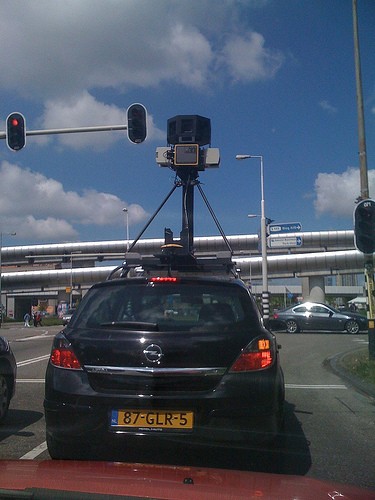
Now that Motorola decided to replace Google's location services for Android with Skyhook, Google needs to improve the accuracy of the results.
{ Photo licensed as Creative Commons by mgroot. }

Visibly attached to the roof of each vehicle is a commercially available Maxrad BMMG24005 omnidirectional radio antenna. This antennae receives publicly broadcast wifi radio signals within range of the vehicle.
The vehicle travels at normal road speeds, and so spends only a very short amount of time within the range of any given wifi access point.
The signals are initially processed onboard in the car, using software including the standard Kismet open source application. The data is then further processed when transferred to servers within a Google Data Centre, and used to compile the Google location based services database.
The equipment within the vehicle operates passively, receiving signals broadcast to it but not actively seeking or initiating a communication with the access point.
The information visible to the equipment is that which is publicly broadcast over the radio network, using the 802.11 standard. This includes the 802.11 b/g/n protocols.
The equipment is able to receive data from all broadcast frames. This includes, from the header data, SSID and MAC addresses. (...) The equipment also separately records the signal strength and channel of the broadcast at the point at which it was received by our equipment, and is able to establish the protocol used (i.e. 802.11b/g/n).
The data which we collect is used to provide location based services within Google products and to users of the Geolocation API. For example, users of Google Maps for Mobile can turn on My Location to identify their approximate location based on cell towers and wifi access points which are visible to their device. (...) Google currently uses 2 pieces of the data collected during the driving operation to build its database and provide location based services - the MAC address of the access point and the GPS co-ordinates of the vehicle at the point at which the access point was visible. This data is stored in aggregate form, and is used to provide the location based service.
Google location based services using wifi access point data work as follows:
* The user's device sends a request to the Google location server with a list of MAC addresses which are currently visible to the device;
* The location server compares the MAC addresses seen by the user's device with its list of known MAC addresses, and identifies associated geocoded locations (i .e. latitude / longitude);
* The location server then uses the geocoded locations associated with visible MAC address to triangulate the approximate location of the user;
* This approximate location is geocoded and sent back to the user's device.
Now that Motorola decided to replace Google's location services for Android with Skyhook, Google needs to improve the accuracy of the results.
{ Photo licensed as Creative Commons by mgroot. }
Disable Google Reader's Social Features
If you don't like Google Reader's social features and you only want to read your subscriptions, you can now switch to the antisocial asocial Google Reader interface:
1. Go to Google Reader
2. Type this JavaScript code in the address bar:
javascript:antisocial('true')
3. Google Reader will reload and you'll see a simplified interface that removes the section "People you follow" and no longer shows shared items from your friends.
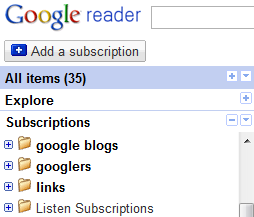
The setting is saved to your account, even if the toggle is not included in the interface. To go back to the standard interface, type this code in the address bar:
javascript:antisocial('false')
{ via George Moga }
1. Go to Google Reader
2. Type this JavaScript code in the address bar:
javascript:antisocial('true')
3. Google Reader will reload and you'll see a simplified interface that removes the section "People you follow" and no longer shows shared items from your friends.

The setting is saved to your account, even if the toggle is not included in the interface. To go back to the standard interface, type this code in the address bar:
javascript:antisocial('false')
{ via George Moga }
April 28, 2010
Creating a Google Account Requires to Enter Your Birthday in the US
If you try to create a new Google account in the US, Google asks for your birthday. Choosing any other country, removes the birthday field and you no longer have to enter this information.
Google's page for creating a new account is famous for only requiring your email address and your country, so it's strange to see that users from the United States have to enter their birthdays.
Google's terms of service say that "you may not use the Services and may not accept the Terms if you are not of legal age to form a binding contract with Google". If you try to enter a date like 4/28/2009, Google shows this message:
"In order to have a Google Account, you must meet certain age requirements. To learn more about online child safety, visit the Federal Trade Commission's website."

{ Thanks, Itamar. }
Google's page for creating a new account is famous for only requiring your email address and your country, so it's strange to see that users from the United States have to enter their birthdays.
Google's terms of service say that "you may not use the Services and may not accept the Terms if you are not of legal age to form a binding contract with Google". If you try to enter a date like 4/28/2009, Google shows this message:
"In order to have a Google Account, you must meet certain age requirements. To learn more about online child safety, visit the Federal Trade Commission's website."

{ Thanks, Itamar. }
Google Updates Mobile Image Search
If there's one thing that I like about Bing's iPhone application is the interface for image search. Google borrowed some ideas from Bing and improved the mobile version of Google Image Search for iPhone and Android.
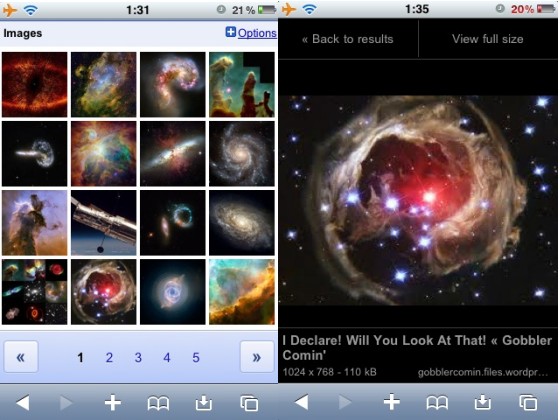
"In the redesign of Google Image Search for mobile, available today for iPhone 3.0+ and Android 2.1 devices, we focused on making it easy to quickly see as many image thumbnails as possible. The thumbnails are square to maximize the number of images we can get on the screen at one time so you can scan them quickly. You can swipe to see the next or previous page of results, or tap the large, stationary 'Next' and 'Previous' page buttons. We optimized for speed so that the images appear quickly when you browse," explains Google.
Google Image Search's interface for iPhone and Android is much better than the desktop interface, which really needs an update. The Sideshow extension for Chrome enhances Google Image Search and other photo sites, but it would be better if Google implemented some of its feature.

"In the redesign of Google Image Search for mobile, available today for iPhone 3.0+ and Android 2.1 devices, we focused on making it easy to quickly see as many image thumbnails as possible. The thumbnails are square to maximize the number of images we can get on the screen at one time so you can scan them quickly. You can swipe to see the next or previous page of results, or tap the large, stationary 'Next' and 'Previous' page buttons. We optimized for speed so that the images appear quickly when you browse," explains Google.
Google Image Search's interface for iPhone and Android is much better than the desktop interface, which really needs an update. The Sideshow extension for Chrome enhances Google Image Search and other photo sites, but it would be better if Google implemented some of its feature.
New YouTube Player
The player recently tested by YouTube is now live for everyone. YouTube's redesigned player has a lot in common with the new YouTube interface: it's simpler and more subtle. Controls fade out if you don't move your mouse, the progress bar is less visible, volume controls are now horizontal. It takes some time to get used to it, but the new player is one of the most brave attempts to minimize complexity in YouTube's user interface.
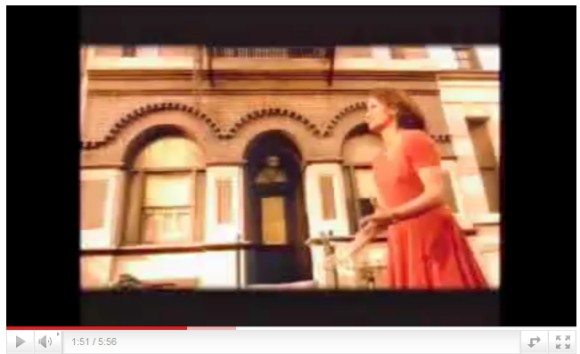
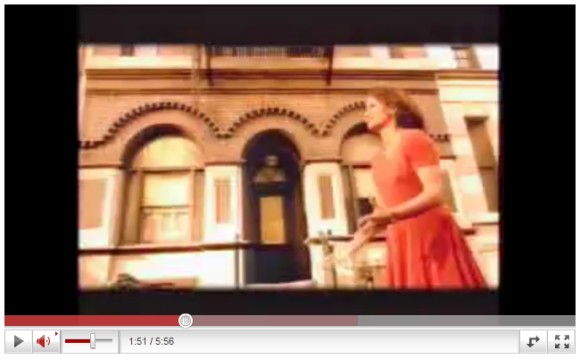
Unfortunately, the new video player has too many moving parts and the animation effects could become annoying. Vimeo's player is even more streamlined and more user-friendly.
Update: The new player is not available for all videos. Here's an example of video that uses the new player.
Update 2: YouTube says that it has "released a new player design for all videos without ads. The goal is for the player to be as subtle as possible so that the video itself shines and doesn't have to compete with the stuff around it. We'll be following this roll-out with player upgrades for videos with ads and then for embedded videos."


Unfortunately, the new video player has too many moving parts and the animation effects could become annoying. Vimeo's player is even more streamlined and more user-friendly.
Update: The new player is not available for all videos. Here's an example of video that uses the new player.
Update 2: YouTube says that it has "released a new player design for all videos without ads. The goal is for the player to be as subtle as possible so that the video itself shines and doesn't have to compete with the stuff around it. We'll be following this roll-out with player upgrades for videos with ads and then for embedded videos."
April 27, 2010
Google OneBox for Similar Pages
Google constantly improves its search algorithms, but not many people notice the changes. Last year, Google has updated the feature that finds similar web pages: it now returns up to 200 pages and the results are much better.
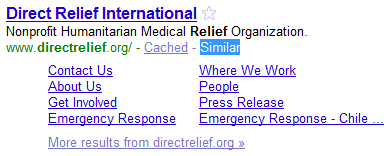
Even if Google shows a link to this feature next to each Google result, few people click on "similar" to find related web pages. That's probably the reason why Google decided to show at the bottom of the search results page an OneBox with pages that are related to the top result, but only if the pages are likely to be helpful and only for navigational queries.
"Since we've been continuously improving this feature and we think it's really useful, we're now going to start showing these alternative sites more prominently," explains Google.
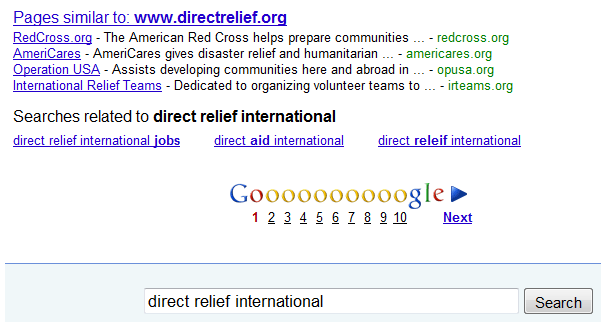
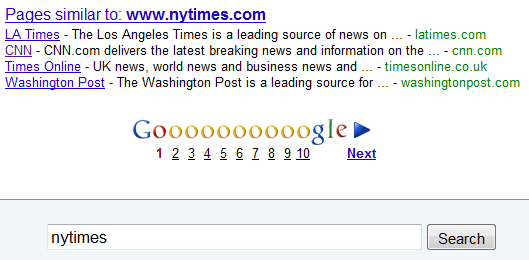
The feature is only available in the US and it's an alternate way to show a list of related searches. Instead of showing similar searches, Google displays a list of pages that are similar to the top result.
If you're wondering how Google manages to find related pages, read this article.

Even if Google shows a link to this feature next to each Google result, few people click on "similar" to find related web pages. That's probably the reason why Google decided to show at the bottom of the search results page an OneBox with pages that are related to the top result, but only if the pages are likely to be helpful and only for navigational queries.
"Since we've been continuously improving this feature and we think it's really useful, we're now going to start showing these alternative sites more prominently," explains Google.


The feature is only available in the US and it's an alternate way to show a list of related searches. Instead of showing similar searches, Google displays a list of pages that are similar to the top result.
If you're wondering how Google manages to find related pages, read this article.
Google Buys LabPixies
Google acquired LabPixies, an Israeli startup that developed high-quality iGoogle gadgets and ported them to other platforms: iPhone, Android, Facebook, OpenSocial. LabPixies created widgets for games, calendars, feed readers, notes and even for ads.
"One of the first developers to create gadgets for iGoogle was Labpixies. Over the years, we worked closely together on a variety of projects, including the launch of a number of global OpenSocial based gadgets. Recently, we decided that we could do more if we were part of the same team, and as such, we're thrilled to announce the acquisition of Labpixies. We are looking forward to working with Labpixies to develop great web apps and leverage their knowledge and expertise to help developers and improve the ecosystem overall," mentions Google Code Blog.
iGoogle really needs some new ideas to remain relevant. The updated interface launched in 2008 and the social gadgets launched last year weren't very popular. For example, the NY Times Crossword gadget developed by LabPixies only has 92,000 users, although it was a featured social gadget.
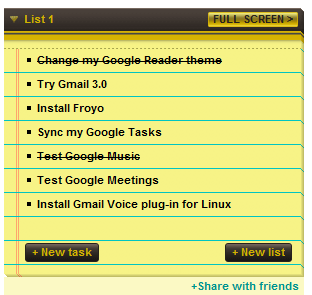
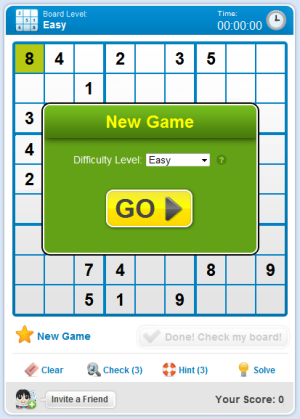
"One of the first developers to create gadgets for iGoogle was Labpixies. Over the years, we worked closely together on a variety of projects, including the launch of a number of global OpenSocial based gadgets. Recently, we decided that we could do more if we were part of the same team, and as such, we're thrilled to announce the acquisition of Labpixies. We are looking forward to working with Labpixies to develop great web apps and leverage their knowledge and expertise to help developers and improve the ecosystem overall," mentions Google Code Blog.
iGoogle really needs some new ideas to remain relevant. The updated interface launched in 2008 and the social gadgets launched last year weren't very popular. For example, the NY Times Crossword gadget developed by LabPixies only has 92,000 users, although it was a featured social gadget.


April 26, 2010
Google Earth Tab in Google Maps
Google Maps replaced the terrain tab with a tab for Google Earth. When you click on the Earth tab, Google asks you to install a plug-in for Windows or Mac. If you have a recent version of Google Earth, you already have the plug-in.
"Five years ago, shortly after Google's acquisition of Keyhole, we introduced the first integration of Keyhole technology into Google Maps -- Satellite view. Suddenly, you could see what places actually looked like from the air, and easily switch between this view and the map view. Mapping has never been the same. A few months later, the desktop Google Earth application was released, and now we have over 600 million downloads. Today we are proud to announce the next major step in the marriage between Google Earth and Google Maps -- Earth view," says Peter Birch, from Google.
Even though the new view makes it easier to use Google Earth, since you no longer have to open a new application, I think it's a bad idea to add it to Google Maps. Google Earth plug-in uses a lot of resources, it slows down your browser and it continues to run in the background even if you switch to the Map tab. What's more, if you open Google Maps in another window and switch to the Earth tab, a new instance of the Google Earth plug-in will load.
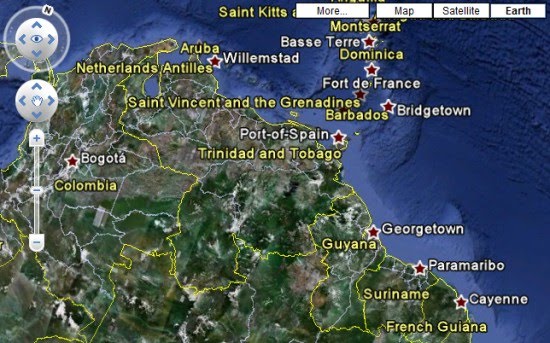
{ Thanks, Andrew. }
"Five years ago, shortly after Google's acquisition of Keyhole, we introduced the first integration of Keyhole technology into Google Maps -- Satellite view. Suddenly, you could see what places actually looked like from the air, and easily switch between this view and the map view. Mapping has never been the same. A few months later, the desktop Google Earth application was released, and now we have over 600 million downloads. Today we are proud to announce the next major step in the marriage between Google Earth and Google Maps -- Earth view," says Peter Birch, from Google.
Even though the new view makes it easier to use Google Earth, since you no longer have to open a new application, I think it's a bad idea to add it to Google Maps. Google Earth plug-in uses a lot of resources, it slows down your browser and it continues to run in the background even if you switch to the Map tab. What's more, if you open Google Maps in another window and switch to the Earth tab, a new instance of the Google Earth plug-in will load.

{ Thanks, Andrew. }
YouTube Auto-Captioning for Classic Novels
YouTube's auto-captioning feature is impressive, even if the results are sometimes hilarious. "Auto-captioning combines some of the speech-to-text algorithms found in Google's Voice Search to automatically generate video captions when requested by a viewer. The video owner can also download the auto-generated captions, improve them, and upload the new version."
Converting speech to text is a difficult technological problem, especially if you can't train the speech recognition software. Here's a video that illustrates how YouTube's audio transcription works for novels (also check the original video):
The results are terrible, but you should take into account that auto-captioning works best for speeches. There are many hilarious mistakes: "George Orwell" is recognized as "but it wasn't", "Lolita" is converted to "don't think so", "the hobbit" is recognized as "the hall", while "cold day" is converted to "cocaine".
And if that's not enough, try to enable auto-captioning for the video embedded above. "This goes on a infinite loop... the transcribe audio function applied to this version transforms entire non-sense phrases into single words," comments RequiemPipes.
{ Thanks, Richard. }
Converting speech to text is a difficult technological problem, especially if you can't train the speech recognition software. Here's a video that illustrates how YouTube's audio transcription works for novels (also check the original video):
The results are terrible, but you should take into account that auto-captioning works best for speeches. There are many hilarious mistakes: "George Orwell" is recognized as "but it wasn't", "Lolita" is converted to "don't think so", "the hobbit" is recognized as "the hall", while "cold day" is converted to "cocaine".
And if that's not enough, try to enable auto-captioning for the video embedded above. "This goes on a infinite loop... the transcribe audio function applied to this version transforms entire non-sense phrases into single words," comments RequiemPipes.
{ Thanks, Richard. }
April 25, 2010
New York Times App for Android?
Andrew B. visited Nexus One's YouTube channel and noticed a demo for an official New York Times application:
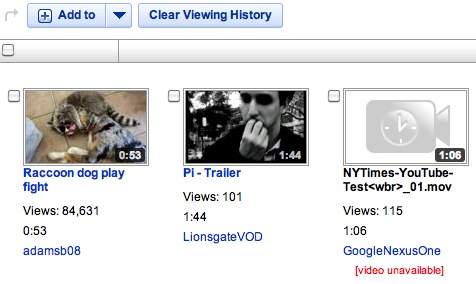
The New York Times application for iPhone is one of the best free apps from Apple's App Store, so it's not surprising to see that Google wanted a similar application for Android.
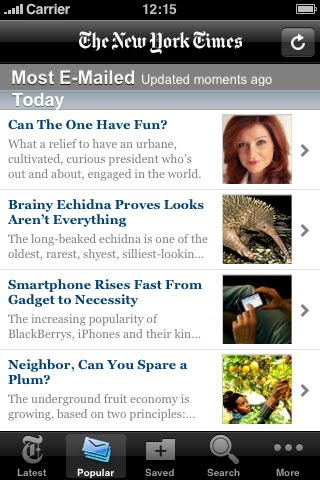
A FAQ page from the NYTimes site has more information:
"The NYTimes application for Android has a unique video display experience, font size adjustment and the ability to share articles via e-mail, SMS, and social apps such as Twitter and Facebook. The NYTimes application for Android works on Android smartphones with operating system version 1.6x or higher. It's available for free at the Android Market (app store). On your Android smartphone, visit nytimes.com/androidapp to download the application."
{ Thanks, Andrew. }
I was on YouTube yesterday and noticed Google's Nexus One channel released a new video. The title looked like it had not been edited because it used underscores instead of spaces and it ended with the file extension.
The video showcased a New York Times app for Android running on the Nexus One with the user flipping through news articles and using the widget. The video has been pulled and I can't find it on either Google's main or Nexus One channel.

The New York Times application for iPhone is one of the best free apps from Apple's App Store, so it's not surprising to see that Google wanted a similar application for Android.

A FAQ page from the NYTimes site has more information:
"The NYTimes application for Android has a unique video display experience, font size adjustment and the ability to share articles via e-mail, SMS, and social apps such as Twitter and Facebook. The NYTimes application for Android works on Android smartphones with operating system version 1.6x or higher. It's available for free at the Android Market (app store). On your Android smartphone, visit nytimes.com/androidapp to download the application."
{ Thanks, Andrew. }
April 24, 2010
Google Trends for Subdomains
At launch, Google Trends for Websites didn't support subdomains. Google's service has been updated and you can now use it to find traffic information about subdomains.
"With Google Trends for Websites, you can get insights into the traffic and geographic visitation patterns of your favorite websites. You can compare data for up to five websites and view related sites and top searches for each one. Trends for Websites combines information from a variety of sources, such as aggregated Google search data, aggregated opt-in anonymous Google Analytics data, opt-in consumer panel data, and other third-party market research," mentions Google.


Google doesn't show traffic stats for most of its domains, but you can find information about blogger.com, vevo.com, android.com, chromium.org, googlelabs.com, orkut.com and obscure domains like ggpht.com, googleusercontent.com and gstatic.com.
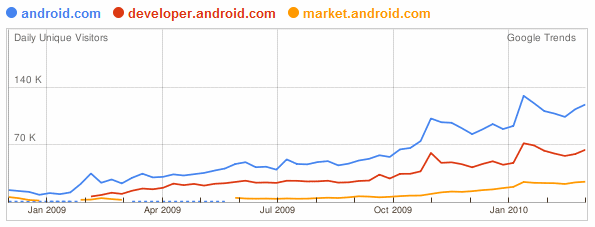
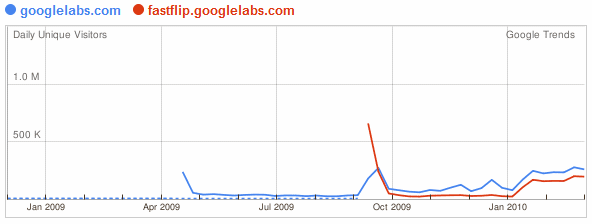

{ Thanks, TOMHTML. }
"With Google Trends for Websites, you can get insights into the traffic and geographic visitation patterns of your favorite websites. You can compare data for up to five websites and view related sites and top searches for each one. Trends for Websites combines information from a variety of sources, such as aggregated Google search data, aggregated opt-in anonymous Google Analytics data, opt-in consumer panel data, and other third-party market research," mentions Google.


Google doesn't show traffic stats for most of its domains, but you can find information about blogger.com, vevo.com, android.com, chromium.org, googlelabs.com, orkut.com and obscure domains like ggpht.com, googleusercontent.com and gstatic.com.



{ Thanks, TOMHTML. }
April 23, 2010
Google Reader Adds Support for Video and Audio Tags
Google's feed reader started to support the video and audio tags from feeds. The only popular browser that doesn't support the two tags is Internet Explorer, but that doesn't mean that you'll be able to play videos without plug-ins in all the other browsers.
As the screenshot below shows, Firefox and Opera don't support the H.264 compression standard, so you can't play videos from sites that only use H.264. Even if video sites like YouTube or Vimeo started to test HTML5 players, they don't offer the option to embed videos using HTML5 tags.
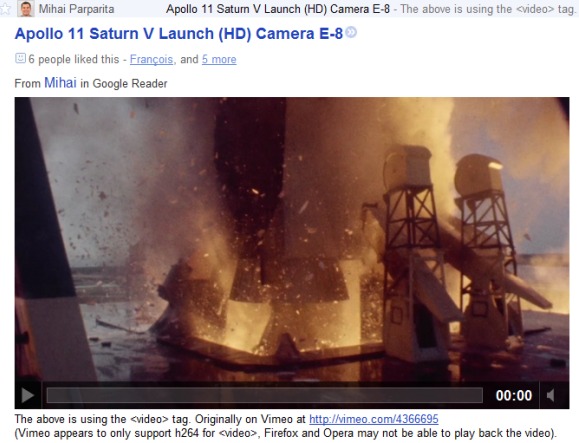
{ via Google Reader's Twitter page. Thanks, François. }
As the screenshot below shows, Firefox and Opera don't support the H.264 compression standard, so you can't play videos from sites that only use H.264. Even if video sites like YouTube or Vimeo started to test HTML5 players, they don't offer the option to embed videos using HTML5 tags.

{ via Google Reader's Twitter page. Thanks, François. }
Two Beautiful Ads for Google Chrome
Even if you don't like Google Chrome, you have to admit that the ads promoting Google's browser are well-crafted. Take, for example, this ad for Google Chrome extensions, which promotes a modern technology using old-fashioned cinematic tricks.
"In keeping with the rustic feel of the ad, the music used is Fats Waller's (Do You Intend to Put an End to) A Sweet Beginning? To keep the explanation simple, ad agency BBH New York has used rudimentary mechanical images, such as a bird popping out of a cuckoo clock and tweeting in the corner of a computer screen and a hamster running in a wheel to drag actual bookmarks between two computers," reports The Guardian.
A second ad promotes the built-in translation feature launched in Google Chrome 4.1. "Both [films] are un-tech-like product demos, showing the work and genius going on behind creating something that is essentially very simple to use," explained Pelle Sjoenell, the executive creative director at BBH.
{ Thanks, François. }
"In keeping with the rustic feel of the ad, the music used is Fats Waller's (Do You Intend to Put an End to) A Sweet Beginning? To keep the explanation simple, ad agency BBH New York has used rudimentary mechanical images, such as a bird popping out of a cuckoo clock and tweeting in the corner of a computer screen and a hamster running in a wheel to drag actual bookmarks between two computers," reports The Guardian.
A second ad promotes the built-in translation feature launched in Google Chrome 4.1. "Both [films] are un-tech-like product demos, showing the work and genius going on behind creating something that is essentially very simple to use," explained Pelle Sjoenell, the executive creative director at BBH.
{ Thanks, François. }
New Ways to Read Feeds in iGoogle
iGoogle added two new views for feeds: a slideshow view for photo feeds and a view that shows the headlines and a snippet from the lead story. You can change the view for each feed by clicking on the arrow icon, selecting "Edit settings" and choosing one of three views: headline only, headline and lead story or slideshow.
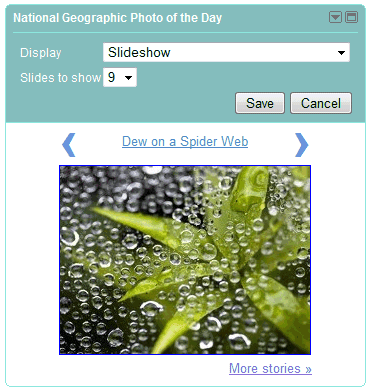

By default, Google shows a small number of hand-picked feeds in the sideshow view and uses the "headline and lead story" view for feeds that support Media RSS. "These new views not only create a better experience for users, but also give publishers an opportunity to more easily expose rich content, often already present in their RSS feeds. To take advantage of this new feature, publishers simply need to add images and associated Media RSS and/or enclosure elements to their existing RSS feeds. We'll then grab the images, resize them down as necessary, and provide hosting/caching. Additionally, we'll make the images clickable and display a 150 character snippet in the Headline and lead story view," explains Google.
There's a guide for publishers which offers more information about the new views. All Blogger feeds use Media RSS, so they'll be displayed in the "headline and lead story" view.


By default, Google shows a small number of hand-picked feeds in the sideshow view and uses the "headline and lead story" view for feeds that support Media RSS. "These new views not only create a better experience for users, but also give publishers an opportunity to more easily expose rich content, often already present in their RSS feeds. To take advantage of this new feature, publishers simply need to add images and associated Media RSS and/or enclosure elements to their existing RSS feeds. We'll then grab the images, resize them down as necessary, and provide hosting/caching. Additionally, we'll make the images clickable and display a 150 character snippet in the Headline and lead story view," explains Google.
There's a guide for publishers which offers more information about the new views. All Blogger feeds use Media RSS, so they'll be displayed in the "headline and lead story" view.
April 22, 2010
Google Maps Adds Kinetic Scrolling
Google Maps has been updated and it now uses kinetic scrolling, a feature inspired by operating systems designed for touch screens. Click on the map, quickly move your mouse and then release it. You'll notice that the map continues to move with the momentum created after you released the mouse.
Now that mobile Google Maps uses the buttons from the desktop interface and both interfaces use kinetic scroll, Google Maps is more consistent.
"Kinetic scrolling is the popular term to denote the scrolling of a long list with a bit of physics so that user feels like moving a wheel. Such a list view is then often referred as a flick list, caused the scrolling involves some sort of flicking gestures. Made popular in iPhone, flick list quickly invades other mobile platforms with touch screen because it just feels so natural and more usable than using the conventional approach of scroll bars," explains Ariya Hidayat.
{ Thanks, que. }
Now that mobile Google Maps uses the buttons from the desktop interface and both interfaces use kinetic scroll, Google Maps is more consistent.
"Kinetic scrolling is the popular term to denote the scrolling of a long list with a bit of physics so that user feels like moving a wheel. Such a list view is then often referred as a flick list, caused the scrolling involves some sort of flicking gestures. Made popular in iPhone, flick list quickly invades other mobile platforms with touch screen because it just feels so natural and more usable than using the conventional approach of scroll bars," explains Ariya Hidayat.
{ Thanks, que. }
Android on an iPhone
A member of the iPhone Dev Team, a group of hacker that develop software for jailbreaking iPhone, managed to install Android on a first-generation iPhone. David Wong replaced Apple's bootloader with the open-source OpeniBoot so that he could install a different operating system. He also used a version of the Linux kernel ported to the iPhone in 2008.
"It should be pretty simple to port forward to the iPhone 3G. The 3GS will take more work. Hopefully with all this groundwork laid out, we can make Android a real alternative or supplement for iPhone users. Maybe we can finally get Flash," says David.
This is one of the many benefits of an open-source software: people can modify it and use it in new, interesting ways. You can install Android on a Windows Mobile phone, on an iPhone, on a notebook and on many other devices.
"It should be pretty simple to port forward to the iPhone 3G. The 3GS will take more work. Hopefully with all this groundwork laid out, we can make Android a real alternative or supplement for iPhone users. Maybe we can finally get Flash," says David.
This is one of the many benefits of an open-source software: people can modify it and use it in new, interesting ways. You can install Android on a Windows Mobile phone, on an iPhone, on a notebook and on many other devices.
Friend Suggestions in Google Chat
The Google Chat gadget from iGoogle's sidebar started to show friend suggestions and they're usually people you've emailed frequently. Google also shows a list of Google Translate bots that help you translate the messages from a conversation.
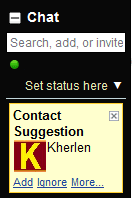

Another new feature lets you send some of your contacts to someone you've emailed frequently.
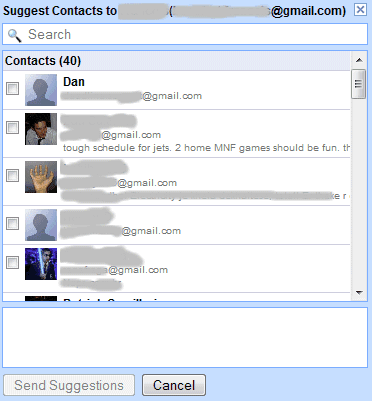
It seems that the suggestions are displayed even if you've enabled this option in Gmail: "Only allow people that I've explicitly approved to chat with me and see when I'm online". By default, Gmail automatically invites to Google Chat the users whom you frequently email. "Gmail determines which contacts you'll be able to talk to without having to invite each other."
{ Thanks, Bogdan. }


Another new feature lets you send some of your contacts to someone you've emailed frequently.

It seems that the suggestions are displayed even if you've enabled this option in Gmail: "Only allow people that I've explicitly approved to chat with me and see when I'm online". By default, Gmail automatically invites to Google Chat the users whom you frequently email. "Gmail determines which contacts you'll be able to talk to without having to invite each other."
{ Thanks, Bogdan. }
April 21, 2010
More Suggestions in Google Maps
Google Maps no longer shows suggestions only from your recent searches. When you start typing a query, Google Maps shows popular locations, searches and local businesses. For example, you can type "red" and the first suggestion is "Redmond, WA, USA".
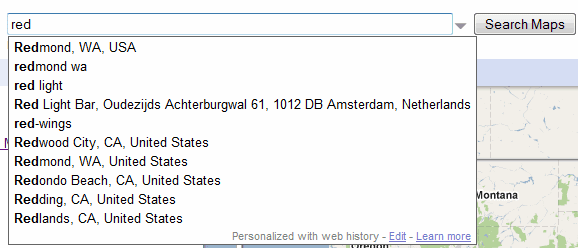
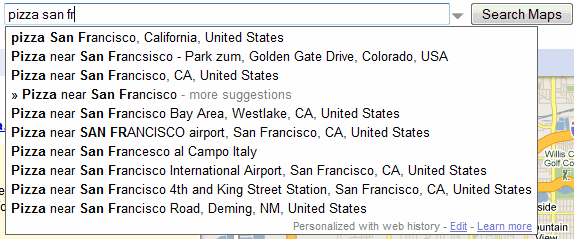
The suggestions are helpful if you want to type a complicated name like Eyjafjallajökull and you only remember the first letters, but Google doesn't do a great job at ranking the list of suggestions.
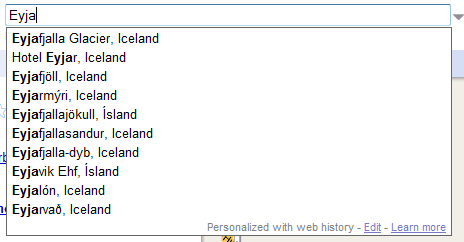
The autocomplete feature from Google Maps is the first implementation of Google Suggest that uses HTTPS. Google Maps continues to show personalized suggestions from Google Web History, a feature that has replaced Saved Locations.


The suggestions are helpful if you want to type a complicated name like Eyjafjallajökull and you only remember the first letters, but Google doesn't do a great job at ranking the list of suggestions.

The autocomplete feature from Google Maps is the first implementation of Google Suggest that uses HTTPS. Google Maps continues to show personalized suggestions from Google Web History, a feature that has replaced Saved Locations.
Google Buzz Layer for Google Maps
The desktop version of Google Maps added a layer that was already available in the mobile interface: a Google Buzz layer. In addition to showing geotagged Google Buzz messages on the map, Google also shows posts from Twitter, FriendFeed and other similar services, so it's strange to see that the layer is called "Buzz". To enable the layer, go to Google Maps, click on the "More" tab and select "Buzz" from the list of layers.
"Find an interesting area like your neighborhood and select any available icon to see what's going on there. In the post's window, click on the name to see the author's public profile, the timestamp to comment on the post, or the place to see it in Maps," suggests Google.
The integration of Google Buzz's mobile app with Google Maps is probably the best feature of the application. When you post a message using the mobile application, Google uses your location to find nearby places and lets you pick one of them. This way, Google Buzz users can post useful information about local businesses without adding a review to Google Maps.


"Find an interesting area like your neighborhood and select any available icon to see what's going on there. In the post's window, click on the name to see the author's public profile, the timestamp to comment on the post, or the place to see it in Maps," suggests Google.
The integration of Google Buzz's mobile app with Google Maps is probably the best feature of the application. When you post a message using the mobile application, Google uses your location to find nearby places and lets you pick one of them. This way, Google Buzz users can post useful information about local businesses without adding a review to Google Maps.


Google Maps Navigation for the UK and Ireland
Google Maps Navigation, the Android application that offers turn-by-turn directions for free, is now available for the UK and Ireland. "Like other satnav devices, Navigation includes 3D views, turn-by-turn voice guidance, and automatic rerouting. But because Google Maps Navigation is connected to the Internet, it also features powerful functionality you can't get from other satnav services, including the most up to date map, business, and traffic data, access to satellite and street views, and of course, search," explains Google.
Google's application could add all the countries available in Google Maps, but the licensing terms don't allow Google to show satellite imagery or driving directions in a real-time navigation application. Last year, Google started to use its own mapping data in the US and it's likely that it will do the same for other countries.
Until Google adds more countries to the application, a developer managed to create Google Maps Brut, a modified version of Google Maps Navigation that supports most countries. Even if Google Maps Brut breaks Google's terms, you can try it by installing Nav Launhcer from the Android Market.
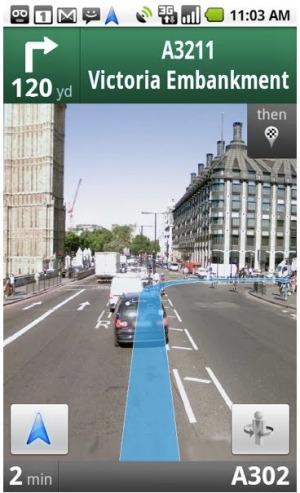
Google Maps Navigation requires Android OS 1.6+ and comes included as a part of Google Maps for Android v3.2 and higher. To update the software, Google suggests to search for [Google Maps] in the Android Market.
Google's application could add all the countries available in Google Maps, but the licensing terms don't allow Google to show satellite imagery or driving directions in a real-time navigation application. Last year, Google started to use its own mapping data in the US and it's likely that it will do the same for other countries.
Until Google adds more countries to the application, a developer managed to create Google Maps Brut, a modified version of Google Maps Navigation that supports most countries. Even if Google Maps Brut breaks Google's terms, you can try it by installing Nav Launhcer from the Android Market.

Google Maps Navigation requires Android OS 1.6+ and comes included as a part of Google Maps for Android v3.2 and higher. To update the software, Google suggests to search for [Google Maps] in the Android Market.
The Best Google Mobile Apps, Only for Android
Google Mobile's page for Android has an interesting message: "The best Google Mobile applications are available for phones that run the Android operating system". That may seem obvious, considering that Google developed a lot of applications only for Android: Gmail, Google Talk, Google Finance, Google Goggles, Google Maps Navigation, Google Shopper and more.
Google's applications are one of the most important competitive advantage for Android, but that doesn't mean that some of the applications couldn't run on other platforms. If Google didn't develop Android, many of the applications would be available in Apple's App Store. Google claims that it takes "great care to ensure that [its tools] ultimately serve you, rather than [its] own internal goal or bottom line", but restricting innovative tools to a single platform doesn't benefit users.
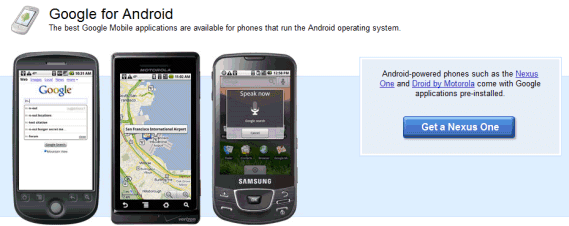
Google's applications are one of the most important competitive advantage for Android, but that doesn't mean that some of the applications couldn't run on other platforms. If Google didn't develop Android, many of the applications would be available in Apple's App Store. Google claims that it takes "great care to ensure that [its tools] ultimately serve you, rather than [its] own internal goal or bottom line", but restricting innovative tools to a single platform doesn't benefit users.

Dots No Longer Required When You Log in to Gmail
Until recently, if your Gmail username included one or more dots, you had to add them to your username when logging in. Now it's no longer required to include the dots, so you can type johndoe instead of john.doe.
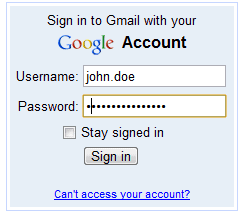
It's important to keep in mind that Gmail ignores the dots from your username when receiving a message, so you'll get all the messages sent to johndoe@gmail.com, john.doe@gmail.com, john.d.o.e@gmail.com and other similar addresses. The requirement to enter the same username you used when you created the Gmail account might have helped you keep the account secure, but it was really annoying.
There's an interesting urban legend about the dots from Gmail usernames: some people claim that Gmail initially allowed users to create different accounts using usernames that were identical if you ignored the dots. That's why you'll hear many users complaining that they receive someone else's mail. Google even created a page which debunks the myth, but that doesn't stop users from talking about the "dot problem".
Update: Apparently, it's not a recent change.
{ Thanks, Michael. }

It's important to keep in mind that Gmail ignores the dots from your username when receiving a message, so you'll get all the messages sent to johndoe@gmail.com, john.doe@gmail.com, john.d.o.e@gmail.com and other similar addresses. The requirement to enter the same username you used when you created the Gmail account might have helped you keep the account secure, but it was really annoying.
There's an interesting urban legend about the dots from Gmail usernames: some people claim that Gmail initially allowed users to create different accounts using usernames that were identical if you ignored the dots. That's why you'll hear many users complaining that they receive someone else's mail. Google even created a page which debunks the myth, but that doesn't stop users from talking about the "dot problem".
Update: Apparently, it's not a recent change.
{ Thanks, Michael. }
April 20, 2010
Google Maps Mixes Search Results with Ads
Google Maps has a new feature for business owners in the US: "for just $25 per month, businesses in select cities can make their listings stand out on Google.com and Google Maps with Tags". Google allows businesses to add yellow markers on the map and to promote their websites.
The new Google Maps ads don't influence ranking, but they make some of the results more visible. "Tags do not affect the rank of search results; they simply add more information when a particular user is searching," explains Google.


Until now, Google Maps ads were clearly separated from the organic search results, just like the ads from Google's web search results pages. For only $25 a month, local businesses can now customize their snippets and add a distinctive marker on the map. This features makes the distinction from search results and ads blurrier.
Google doesn't allow publishers to pay for advanced features like customizing snippets, adding rich snippets, showing thumbnails or favicons next to search results. "Google doesn't accept payment to crawl a site more frequently, and we keep the search side of our business separate from our revenue-generating AdWords service," mentions an article from Google's help center for webmasters.
In other related news, Google Local Business Center is now known as Google Places and businesses from US, Japan and Australia can apply for a Google photo shoot. "Google's photographers are specially trained to take great photos of building interiors, dealing with some of the challenges such as low lighting and tight spaces. The photographers are also trained to take panoramic pictures using fisheye and wide angle lenses that should translate into great looking pictures of your business."
The new Google Maps ads don't influence ranking, but they make some of the results more visible. "Tags do not affect the rank of search results; they simply add more information when a particular user is searching," explains Google.


Until now, Google Maps ads were clearly separated from the organic search results, just like the ads from Google's web search results pages. For only $25 a month, local businesses can now customize their snippets and add a distinctive marker on the map. This features makes the distinction from search results and ads blurrier.
Google doesn't allow publishers to pay for advanced features like customizing snippets, adding rich snippets, showing thumbnails or favicons next to search results. "Google doesn't accept payment to crawl a site more frequently, and we keep the search side of our business separate from our revenue-generating AdWords service," mentions an article from Google's help center for webmasters.
In other related news, Google Local Business Center is now known as Google Places and businesses from US, Japan and Australia can apply for a Google photo shoot. "Google's photographers are specially trained to take great photos of building interiors, dealing with some of the challenges such as low lighting and tight spaces. The photographers are also trained to take panoramic pictures using fisheye and wide angle lenses that should translate into great looking pictures of your business."
Virtual Keyboard for Google Search
Google started to show a virtual keyboard next to the search box if you use Google search's interface in a non-Latin language like Arabic, Russian or Greek.
"Our virtual keyboard allows you to enter the precise search terms you want, regardless of the language keys on your physical keyboard. It can be helpful for people who use one of the many non-Latin script-based languages that require special characters," explains Google.
Here's an example of virtual keyboard for Mongolian:

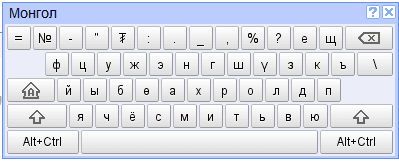
The nice thing about Google's virtual keyboard is that, after clicking on the keyboard icon next to the search box, you can use the keys from the virtual keyboard or you can use your keyboard. "The corresponding key on the virtual keyboard will be typed in the search box rather than the character shown on your physical keyboard."
An incomplete list of Google domains that show the virtual keyboard: Google Greece, Google Finland, Google Sweden, Google Iceland, Google Poland, Google Russia, Google Ukraine, Google Saudi Arabia, Google Thailand, Google Mongolia, Google India and others.
Google has a lot of useful services for non-Latin languages: Google Transliteration, Google Transliteration IME, Google Pinyin IME, a tool for adding missing diacritics to Arabic text, Google Translate.
{ Thanks, Kherlen and Zorgloob. }
"Our virtual keyboard allows you to enter the precise search terms you want, regardless of the language keys on your physical keyboard. It can be helpful for people who use one of the many non-Latin script-based languages that require special characters," explains Google.
Here's an example of virtual keyboard for Mongolian:


The nice thing about Google's virtual keyboard is that, after clicking on the keyboard icon next to the search box, you can use the keys from the virtual keyboard or you can use your keyboard. "The corresponding key on the virtual keyboard will be typed in the search box rather than the character shown on your physical keyboard."
An incomplete list of Google domains that show the virtual keyboard: Google Greece, Google Finland, Google Sweden, Google Iceland, Google Poland, Google Russia, Google Ukraine, Google Saudi Arabia, Google Thailand, Google Mongolia, Google India and others.
Google has a lot of useful services for non-Latin languages: Google Transliteration, Google Transliteration IME, Google Pinyin IME, a tool for adding missing diacritics to Arabic text, Google Translate.
{ Thanks, Kherlen and Zorgloob. }
April 16, 2010
Google Cloud Print
Google found an interesting solution for printing documents in Chrome OS. Instead of preloading the drivers for the most popular printers, Chrome OS will use an online service for printing: Google Cloud Print.
The only problem is that no printer supports Google Cloud Print and that's why Google revealed some details about the service's interfaces, hoping that printer manufacturers will update their software and support it. If a printer doesn't support Google's service, you'll need a proxy software for the computer where the printer is installed. Google says that the proxy software will be bundled with Google Chrome.
Google wants to associate your printers with a Google account and manage them the same way as you manage Google Docs documents, so you can share them with other people. Web applications can use APIs to customize the printing options and change the user interface displayed when you start printing a document.
"We believe cloud printing has tremendous benefits for end users and for the industry and is essential, given the rapid shift toward cloud-based applications and data storage. We also believe that the only way that the benefits of cloud printing can be realized is if the protocols are open, freely implementable, and, when possible, based on existing industry standards. We expect there to be multiple cloud print services, and users should have a choice in which services they use and which printers they can connect to a service. Stay tuned for more details. We are confident that cloud-aware printers will soon be a reality," suggests Google.
It may seem that Google's solution is complicated and difficult to implement: we need an open standard for cloud printing, cloud-aware printers and users need to associate printers with an online service. Instead of sending the printing job directly to the printer, you'll send it to the online service, which forwards it to the printer. Despite all these hurdles, Google Cloud Print allows you to print documents from a mobile phone, tablet, notebook or any other mobile device. You'll be able to print files from an Android phone or tablet, from a Chrome OS computer, from any computer that runs Google Chrome and from other devices that will support Google Cloud Print.

In Google Chrome OS, all applications are web apps. Therefore, in designing the printing experience for Google Chrome OS, we want to make sure printing from web apps is as natural as printing from traditional native apps is today. Additionally, with the proliferation of web-connected mobile devices such as those running Google Chrome OS and other mobile operating systems, we don't believe it is feasible to build and maintain complex print subsystems and print drivers for each platform. In fact, even the print subsystems and drivers on existing PC operating systems leave a lot of room for improvement.
Our goal is to build a printing experience that enables any app (web, desktop, or mobile) on any device to print to any printer anywhere in the world. This goal is accomplished through the use of a cloud print service. Apps no longer rely on the local operating system (and drivers) to print. Instead, apps (whether they be a native desktop/mobile app or a web app) use Google Cloud Print to submit and manage print jobs. Google Cloud Print is then responsible for sending the print job to the appropriate printer, with the particular options the user selected, and providing job status to the app.
The only problem is that no printer supports Google Cloud Print and that's why Google revealed some details about the service's interfaces, hoping that printer manufacturers will update their software and support it. If a printer doesn't support Google's service, you'll need a proxy software for the computer where the printer is installed. Google says that the proxy software will be bundled with Google Chrome.
Google wants to associate your printers with a Google account and manage them the same way as you manage Google Docs documents, so you can share them with other people. Web applications can use APIs to customize the printing options and change the user interface displayed when you start printing a document.
"We believe cloud printing has tremendous benefits for end users and for the industry and is essential, given the rapid shift toward cloud-based applications and data storage. We also believe that the only way that the benefits of cloud printing can be realized is if the protocols are open, freely implementable, and, when possible, based on existing industry standards. We expect there to be multiple cloud print services, and users should have a choice in which services they use and which printers they can connect to a service. Stay tuned for more details. We are confident that cloud-aware printers will soon be a reality," suggests Google.
It may seem that Google's solution is complicated and difficult to implement: we need an open standard for cloud printing, cloud-aware printers and users need to associate printers with an online service. Instead of sending the printing job directly to the printer, you'll send it to the online service, which forwards it to the printer. Despite all these hurdles, Google Cloud Print allows you to print documents from a mobile phone, tablet, notebook or any other mobile device. You'll be able to print files from an Android phone or tablet, from a Chrome OS computer, from any computer that runs Google Chrome and from other devices that will support Google Cloud Print.

Labels:
Google Chrome,
Google Chrome OS,
Mobile
April 15, 2010
Drag and Drop Gmail Attachments
Gmail added support for a HTML5 feature that has been recently included in Firefox and Google Chrome: selecting files using drag and drop. If you use Firefox 3.6+ or Chrome 4+, you can now add attachments by dragging the files from your favorite file manager to Gmail. When you drag the files, Gmail shows a drop zone where you need to place the files.
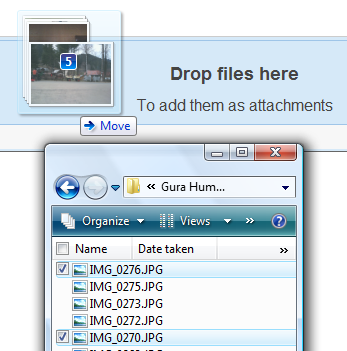
"We'll enable this for other browsers as soon as they support this feature. For now, you can drag and drop attachments in Chrome and Firefox only," mentions Google.
The nice thing about this feature is that it no longer uses the Flash uploader, which isn't very reliable. What I don't understand is why Gmail still uses the Flash uploader to select multiple files directly from the browser, now that the input tag supports more than one file. If you disable Flash in Firefox 3.6 and don't use drag and drop, you can only attach one file at a time:

{ Thanks, Sterling. }

"We'll enable this for other browsers as soon as they support this feature. For now, you can drag and drop attachments in Chrome and Firefox only," mentions Google.
The nice thing about this feature is that it no longer uses the Flash uploader, which isn't very reliable. What I don't understand is why Gmail still uses the Flash uploader to select multiple files directly from the browser, now that the input tag supports more than one file. If you disable Flash in Firefox 3.6 and don't use drag and drop, you can only attach one file at a time:

{ Thanks, Sterling. }
Gmail's New Interface for Adding Event Invitations
Gmail is even more integrated with Google Calendar: when you compose a new message, you'll find a new interface for sending invitations. Click "Insert invitation" and Gmail opens a new dialog that lets you find the best time for your even by showing the events from your calendar and from the calendars of people you are inviting. You can also type the location of the event, a description and choose a calendar for the event.

After entering all the details, the event is added to the email message and you can still edit the event or remove it.

{ Thanks, Abhijeet. }

After entering all the details, the event is added to the email message and you can still edit the event or remove it.

{ Thanks, Abhijeet. }
April 14, 2010
Google Chat Enhances Links to Google Maps
When you type a link to Google Maps search results in Gmail Chat, iGoogle Chat or orkut's chat box, Google replaces the long URL with the Google Maps query. Google Maps URLs are usually very long because they include a lot of parameters, but Google should do a better job at removing extraneous parameters.
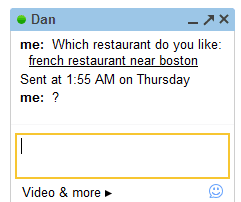
"On the Gmail version of Google Talk, Google now shortens the links and makes them readable. For example, it changes the link: http://maps.google.com/maps?f=q&source=s_q&hl=en&geocode=&q=HEB+near+college+station,+tx&sll=30.606817,-96.309929&sspn=0.050086,0.090895&ie=UTF8&hq=HEB&hnear=College+Station,+TX&ll=30.6128,-96.318512&spn=0.050083,0.090895&z=14 to a link where the text is HEB near College Station, TX," noticed Korben, a reader of this blog.
{ Thanks, Korben. }

"On the Gmail version of Google Talk, Google now shortens the links and makes them readable. For example, it changes the link: http://maps.google.com/maps?f=q&source=s_q&hl=en&geocode=&q=HEB+near+college+station,+tx&sll=30.606817,-96.309929&sspn=0.050086,0.090895&ie=UTF8&hq=HEB&hnear=College+Station,+TX&ll=30.6128,-96.318512&spn=0.050083,0.090895&z=14 to a link where the text is HEB near College Station, TX," noticed Korben, a reader of this blog.
{ Thanks, Korben. }
Twitter Timeline in Google Real-Time Search
Google's real-time search results have been enhanced with a timeline restricted to Twitter messages.
"The first page will show you the familiar latest and greatest short-form updates from a comprehensive set of sources, but now there's a new chart at the top. The chart shows the relative volume of activity on Twitter about the topic," explains Google.
For now, Google's timelines show Twitter messages posted since February 11, but Google promises that they will be extended to the entire Twitter archive. After all, Google paid Twitter to have access to the data.
Here are some examples of searches that show the timeline: [Toyota], [Android], [Shakespeare], [Happy new year].
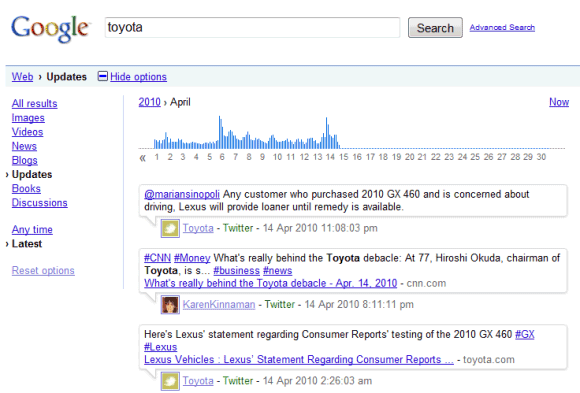
In other Twitter-related news, Google Labs launched Follow Finder, a new service that recommends a list of Twitter users to follow. Google analyzed Twitter's social graph and it's able to recommend other Twitter users that are followed by people who follow the users you do.
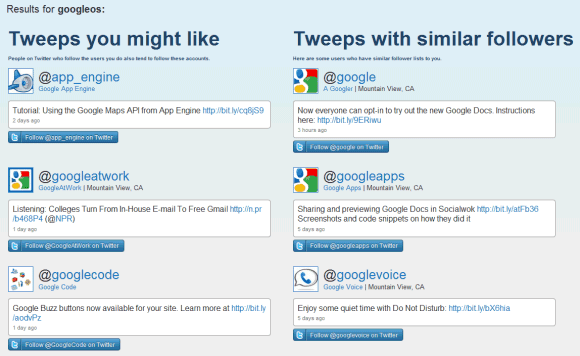
"The first page will show you the familiar latest and greatest short-form updates from a comprehensive set of sources, but now there's a new chart at the top. The chart shows the relative volume of activity on Twitter about the topic," explains Google.
For now, Google's timelines show Twitter messages posted since February 11, but Google promises that they will be extended to the entire Twitter archive. After all, Google paid Twitter to have access to the data.
Here are some examples of searches that show the timeline: [Toyota], [Android], [Shakespeare], [Happy new year].

In other Twitter-related news, Google Labs launched Follow Finder, a new service that recommends a list of Twitter users to follow. Google analyzed Twitter's social graph and it's able to recommend other Twitter users that are followed by people who follow the users you do.

Eric Schmidt on Chrome OS
At Google Atmosphere, a CIO event about cloud computing, Eric Schmidt explained why Chrome OS is meaningful:
"The promise of Chrome and Chrome OS is that the devices that you give to your employees will have a 2-second boot time, will be completely disposable and the price will be incredibly low."
Chrome OS computers will no longer be personal because it doesn't matter which computer you use. After logging to your Google account, Chrome OS will retrieve your bookmarks, themes, settings, web history from Google's servers. Your data is stored in a central location and you can access it from all your devices.
Computers will boot almost instantly, so you no longer have to wait. They'll be cheap, easy to replace and to maintain.
You can already use Chrome on your computer, but a Chrome OS computer is optimized for running a browser, doesn't have extraneous software and it's inherently more secure.
"The promise of Chrome and Chrome OS is that the devices that you give to your employees will have a 2-second boot time, will be completely disposable and the price will be incredibly low."
Chrome OS computers will no longer be personal because it doesn't matter which computer you use. After logging to your Google account, Chrome OS will retrieve your bookmarks, themes, settings, web history from Google's servers. Your data is stored in a central location and you can access it from all your devices.
Computers will boot almost instantly, so you no longer have to wait. They'll be cheap, easy to replace and to maintain.
You can already use Chrome on your computer, but a Chrome OS computer is optimized for running a browser, doesn't have extraneous software and it's inherently more secure.
April 13, 2010
Google Will Open Source On2 VP8 Codec
NewTeeVee reports that Google will soon open source VP8, the latest video codec released by On2, a company acquired by Google for $133 million.
On2 is the company that open-sourced VP3, which has been further developed and it's now known as Theora. "In June 2002 On2 donated VP3 to the Xiph.Org Foundation under a BSD-like open source license. On2 also made an irrevocable, royalty-free license grant for any patent claims it might have over the software and any derivatives, allowing anyone to use any VP3-derived codec for any purpose. In August 2002, On2 entered into an agreement with the Xiph.Org Foundation to make VP3 the basis of a new, free video codec, called Theora."
Now that browsers have native support for playing videos, many wondered what is the best video format for the web. Firefox, Opera support Theora videos, Safari plays H.264 videos, while Google Chrome supports both formats.
"Although the h264 codec has gained dominance due to its excellent compression and broad support in the consumer electronics ecosystem, it is covered by patents that preclude broad royalty-free usage. (...) Ogg [Theora] may offer advantages from a licensing standpoint, but there are still many unanswered questions about its quality and suitability for Internet video streaming services," explains Ars Technica.
Open-sourcing VP8 could solve the problem, although it could take years until Google releases the code and browsers start to support the new format. Despite all the hurdles, it's rare to see a company that pays more than $100 million to open source a video codec.
"Today video is an essential part of the web experience, and we believe high-quality video compression technology should be a part of the web platform," said Google's Sundar Pichai, when Google announced the On2 acquisition.
Here's what the Free Software Foundation wrote in an open letter to Google:
"With your purchase of On2, you now own both the world's largest video site (YouTube) and all the patents behind a new high performance video codec -- VP8. Just think what you can achieve by releasing the VP8 codec under an irrevocable royalty-free license and pushing it out to users on YouTube? You can end the web's dependence on patent-encumbered video formats and proprietary software (Flash)."

{ Image licensed as Creative Commons by yummiec00kies. }
On2 is the company that open-sourced VP3, which has been further developed and it's now known as Theora. "In June 2002 On2 donated VP3 to the Xiph.Org Foundation under a BSD-like open source license. On2 also made an irrevocable, royalty-free license grant for any patent claims it might have over the software and any derivatives, allowing anyone to use any VP3-derived codec for any purpose. In August 2002, On2 entered into an agreement with the Xiph.Org Foundation to make VP3 the basis of a new, free video codec, called Theora."
Now that browsers have native support for playing videos, many wondered what is the best video format for the web. Firefox, Opera support Theora videos, Safari plays H.264 videos, while Google Chrome supports both formats.
"Although the h264 codec has gained dominance due to its excellent compression and broad support in the consumer electronics ecosystem, it is covered by patents that preclude broad royalty-free usage. (...) Ogg [Theora] may offer advantages from a licensing standpoint, but there are still many unanswered questions about its quality and suitability for Internet video streaming services," explains Ars Technica.
Open-sourcing VP8 could solve the problem, although it could take years until Google releases the code and browsers start to support the new format. Despite all the hurdles, it's rare to see a company that pays more than $100 million to open source a video codec.
"Today video is an essential part of the web experience, and we believe high-quality video compression technology should be a part of the web platform," said Google's Sundar Pichai, when Google announced the On2 acquisition.
Here's what the Free Software Foundation wrote in an open letter to Google:
"With your purchase of On2, you now own both the world's largest video site (YouTube) and all the patents behind a new high performance video codec -- VP8. Just think what you can achieve by releasing the VP8 codec under an irrevocable royalty-free license and pushing it out to users on YouTube? You can end the web's dependence on patent-encumbered video formats and proprietary software (Flash)."

{ Image licensed as Creative Commons by yummiec00kies. }
How to Try the New Google Docs Apps
Here's how to try Google Drawings and the new interfaces of Google Documents and Google Spreadsheets:
* create a new drawing by opening the documents list, clicking on "Create new" and selecting "Drawing".

* to see the new document editor, go to the settings page, click on the "Editing" tab and select "Create new text documents using the latest version of the document editor." Unfortunately, you can't see the existing documents in the new interface. The new document editor is code-named "kix" and it's a completely new application.

* to switch to the new spreadsheets editor, open a spreadsheet and click on "New version" at the top of the page. All spreadsheets will now open in the new interface.

The new interface is not yet available for presentations.
* create a new drawing by opening the documents list, clicking on "Create new" and selecting "Drawing".

* to see the new document editor, go to the settings page, click on the "Editing" tab and select "Create new text documents using the latest version of the document editor." Unfortunately, you can't see the existing documents in the new interface. The new document editor is code-named "kix" and it's a completely new application.

* to switch to the new spreadsheets editor, open a spreadsheet and click on "New version" at the top of the page. All spreadsheets will now open in the new interface.

The new interface is not yet available for presentations.
April 12, 2010
Google Buys Plink to Improve Visual Mobile Search
Google acquired Plink, a small startup that developed Plink Art, an Android application that lets you identify paintings using your mobile phone's camera. Plink Art was one of the winners of the Android Developer Challenge 2. You can find the application in Android's market: just search for [Plink Art].
"The coolest feature of Plink Art is instant art identification. Just snap a photo and if the painting is in our database our visual search system will recognize it and tell you all about it. Currently Plink knows about tens of thousands of famous paintings," explains Plink's website.
I tried the application on my Nexus One by taking photos of Google Image Search results, but the results were terrible. Google Goggles found much better results for the same images.

The two Plink co-founders and only employees will work to improve Google Goggles, a visual search tool that already lets you find books, places and artwork. From Plink's blog:
"We started Plink to bring the power of visual search to everyone, and we're delighted to be taking a big step towards that goal today. Google has already shown that it's serious about investing in this space with Google Goggles, and for the Plink team the opportunity to take our algorithms to Google-scale was just too exciting to pass up. The visual search engines of today can do some pretty cool things, but they still have a long long way to go. We're looking forward to helping the Goggles team build a visual search engine that works not just for paintings or book covers, but for everything you see around you. There are beautiful things to be done with computer vision – it's going to be a lot of fun!"
{ via LA Times Blog}
"The coolest feature of Plink Art is instant art identification. Just snap a photo and if the painting is in our database our visual search system will recognize it and tell you all about it. Currently Plink knows about tens of thousands of famous paintings," explains Plink's website.
I tried the application on my Nexus One by taking photos of Google Image Search results, but the results were terrible. Google Goggles found much better results for the same images.

The two Plink co-founders and only employees will work to improve Google Goggles, a visual search tool that already lets you find books, places and artwork. From Plink's blog:
"We started Plink to bring the power of visual search to everyone, and we're delighted to be taking a big step towards that goal today. Google has already shown that it's serious about investing in this space with Google Goggles, and for the Plink team the opportunity to take our algorithms to Google-scale was just too exciting to pass up. The visual search engines of today can do some pretty cool things, but they still have a long long way to go. We're looking forward to helping the Goggles team build a visual search engine that works not just for paintings or book covers, but for everything you see around you. There are beautiful things to be done with computer vision – it's going to be a lot of fun!"
{ via LA Times Blog}
Labels:
Android,
Google Goggles,
Image Search,
Mobile
Subscribe to:
Posts (Atom)
